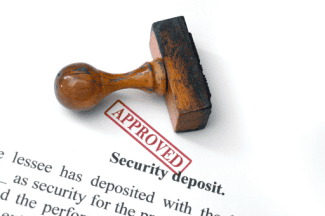A Security Deposit is Not a Move-In Fee is Not a Security Deposit
There seems to be quite a bit of confusion on the part of landlords and renters alike as to the difference between a security deposit and a move-in fee. The biggest difference between the two is that one is refundable and the other is not. Both are government-regulated in many states.
What is a Security Deposit?

Once the tenancy is over, the landlord will deduct the amount needed from the deposit to cover the cost of any damage done, cleaning costs, unpaid rent, unpaid utility bills, or other costs associated with violations of lease terms before it is returned to the tenant.
The amount of the security deposit is usually based on monthly rent and can range from the equivalent of one month to three month’s rent depending upon the laws governing the location of the property.
Maximum security deposits vary from state to state. Some allow up to three month’s rent for a furnished apartment while some states, such as Colorado, Florida, Georgia and others have no specific laws at all. Some states require that the tenant be paid interest on the money that has been held when they move out.
As an example, Iowa landlords must start paying their tenants interest on their security deposit after a tenancy has been in effect for five years. If tenancy is under five years, the landlord is entitled to retain any accrued interest. In Kansas, the landlord is entitled to any accrued interest earned. In Maryland, landlords must pay interest on deposits of $50 or more when they have been held for at least six months.
With the increase in tenant-friendly laws currently being passed, many states are addressing the amounts landlords can require as security deposits. For instance, California Governor Gavin Newsom recently signed into law a reduction of the allowable amount for a security deposit in his state. Set to go into effect on July 1, 2024, Assembly Bill 12 limits security deposits to no more than one month’s rent.
AAOA members can access a Rental Property Deposit Agreement at no cost to outline the terms of the security deposit.
What is a Move-In Fee?
Unlike a security deposit, a move-in fee is not refundable. It can be used to cover the cost of a tenant credit check, a landlord background screening, or possibly cleaning expenses. A move-in fee is money that the tenant will never see again; as soon as the tenant pays the move-in fee, it becomes the property of the landlord.
Generally, the move-in charge is for services rendered by the landlord prior to a new tenant taking possession of the unit, such as freshening up the home, replacing locks or purchasing a new set of keys. Usually, a move-in fee which costs about 20-50% of the rent is legal. Most states, such as Utah and Missouri, do not cap the amount a property manager can charge for a move-in fee or control what a move-in fee can be used for.
Non-refundable fees do not need to be kept in an interest-bearing account or returned once the tenant moves out, making them easier for the landlord to manage.
In many cases, a landlord will ask for both a move-in fee and a security deposit. This is not only legal, but it is also very common, as the landlord will likely want to make upgrades to the unit before move-in and clean up the unit at move-out.
Move-in fees are usually much less than security deposits, so potential renters may be more likely to agree to this cost and sign the lease. The landlord does not need to return a move-in fee to a renter when they move out. Even if the tenants leave the unit in pristine condition, the landlord gets to keep the move-in fee.
To avoid problems at move-out, landlords should be careful to label the fee as “nonrefundable” on the lease or tenants might later claim that they believed the fee to be a refundable security deposit.
Need a Lease Agreement?
Access 150+ state-specific legal landlord forms, including a lease.
A Quick Look at Security Deposits vs. Move-In Fees
|
SECURITY DEPOSITS |
MOVE-IN FEES |
|
Pre-determined amount most landlords hold until the end of the renter’s tenancy |
Non-refundable fee charged to new tenants before they take occupancy |
|
Must be held in a separate account. Used to re-coup unpaid rent or damages to rental property |
Covers the cost of preparing the unit for occupancy by new tenants |
|
Some states require the landlord to pay interest to tenants |
Landlords do not have to pay interest on move-in fees |
|
Funds are the property of the tenants until refunded |
As soon as the tenant pays the move-in fee, it becomes the property of the landlord
|
Some landlords charge their new tenants both a security deposit and a move-in fee. Choosing whether or not to charge a move-in fee and setting an appropriate amount is an important part of the rental process. Even if you fairly assess move-in fees and security deposits, dealing with the aftermath of a destructive tenant can be an expensive headache that can be avoided by conducting an AAOA background and credit screening.
Disclaimer: All content provided here-in is subject to AAOA’s Terms of Use.
Nothing contained on this website constitutes tax, legal, insurance or investment advice, nor does it constitute a solicitation or an offer to buy or sell any security or other financial instrument. AAOA recommends you consult with a financial advisor, tax specialist, attorney or other specialist who is able to properly advise you.















 Accessibility
Accessibility